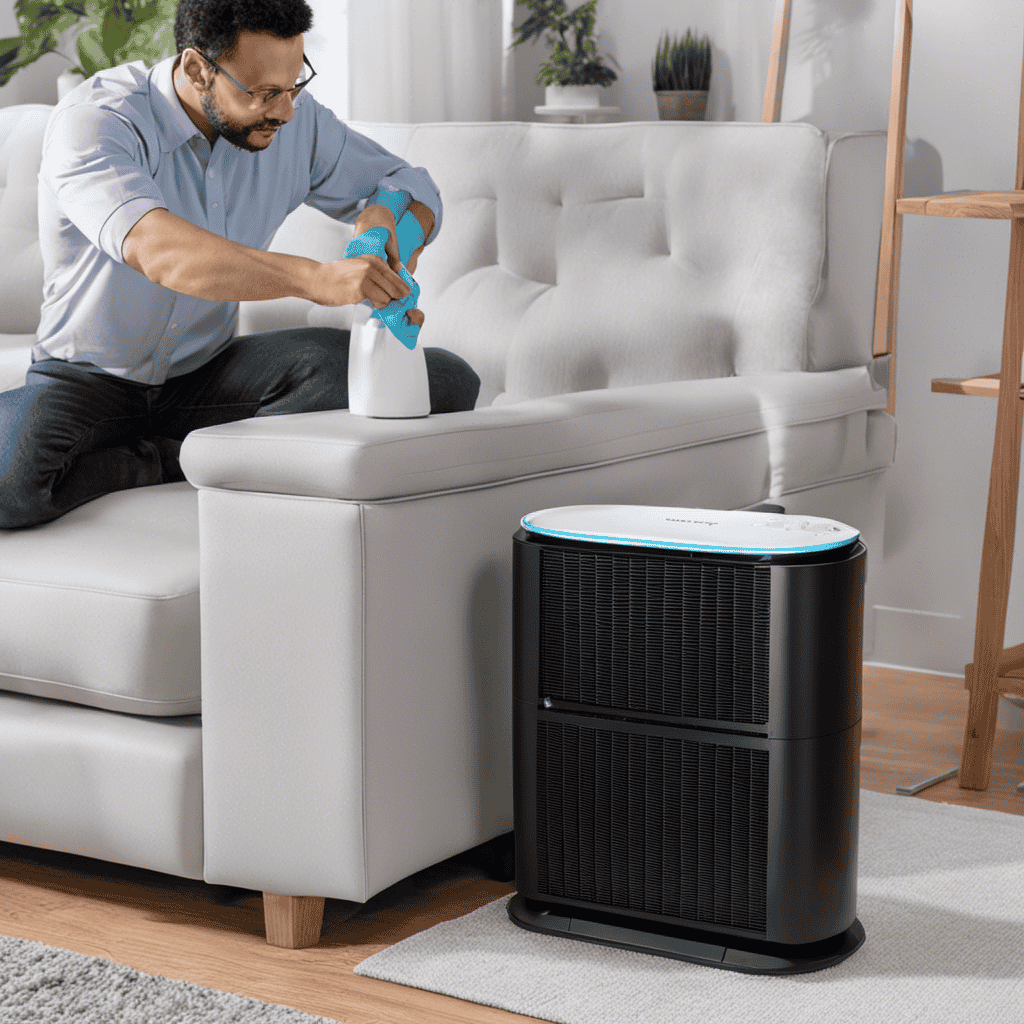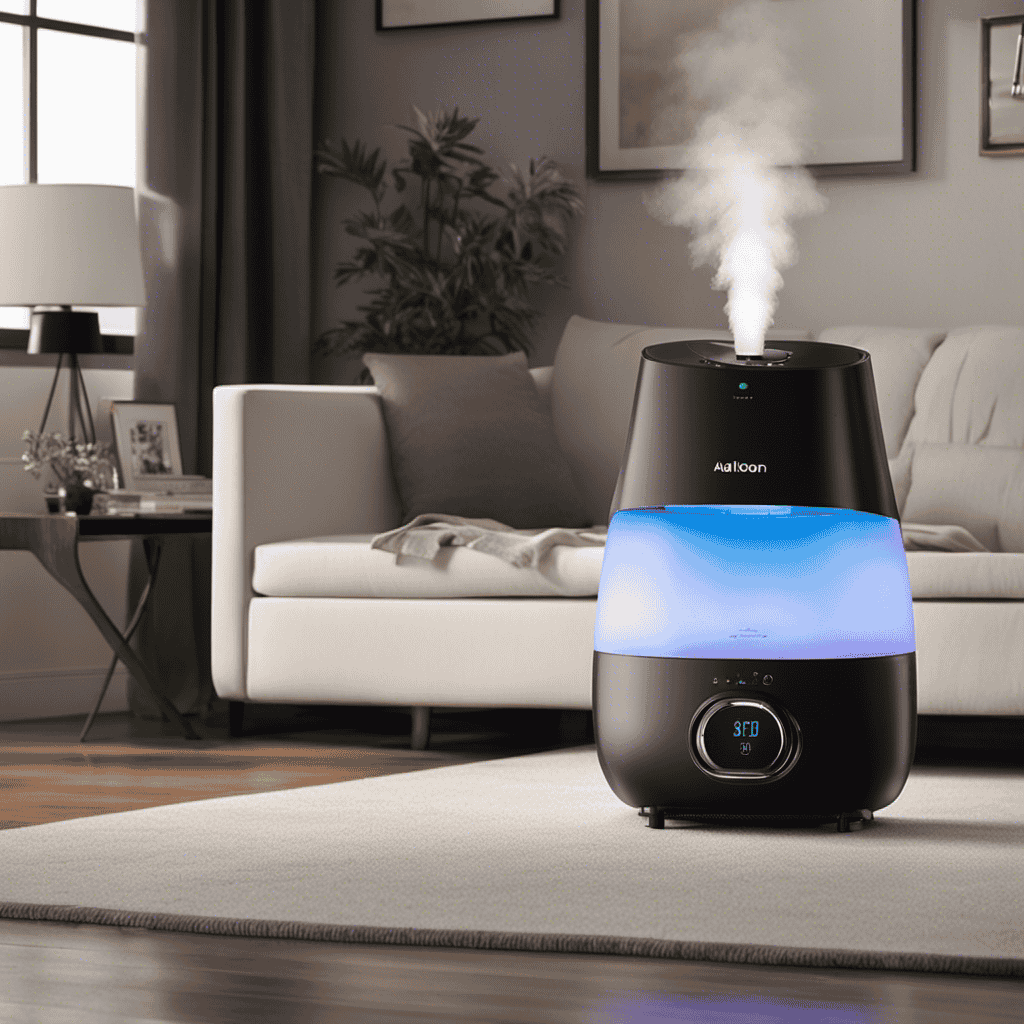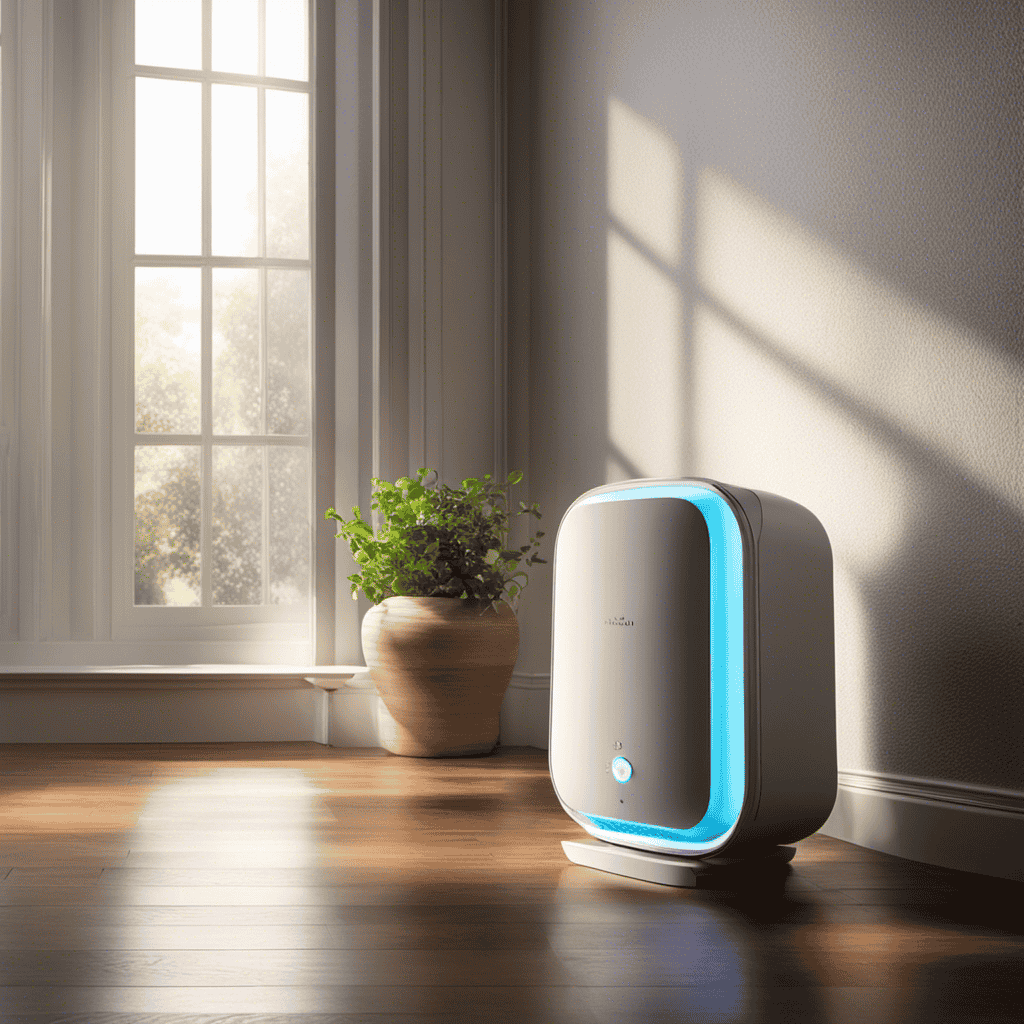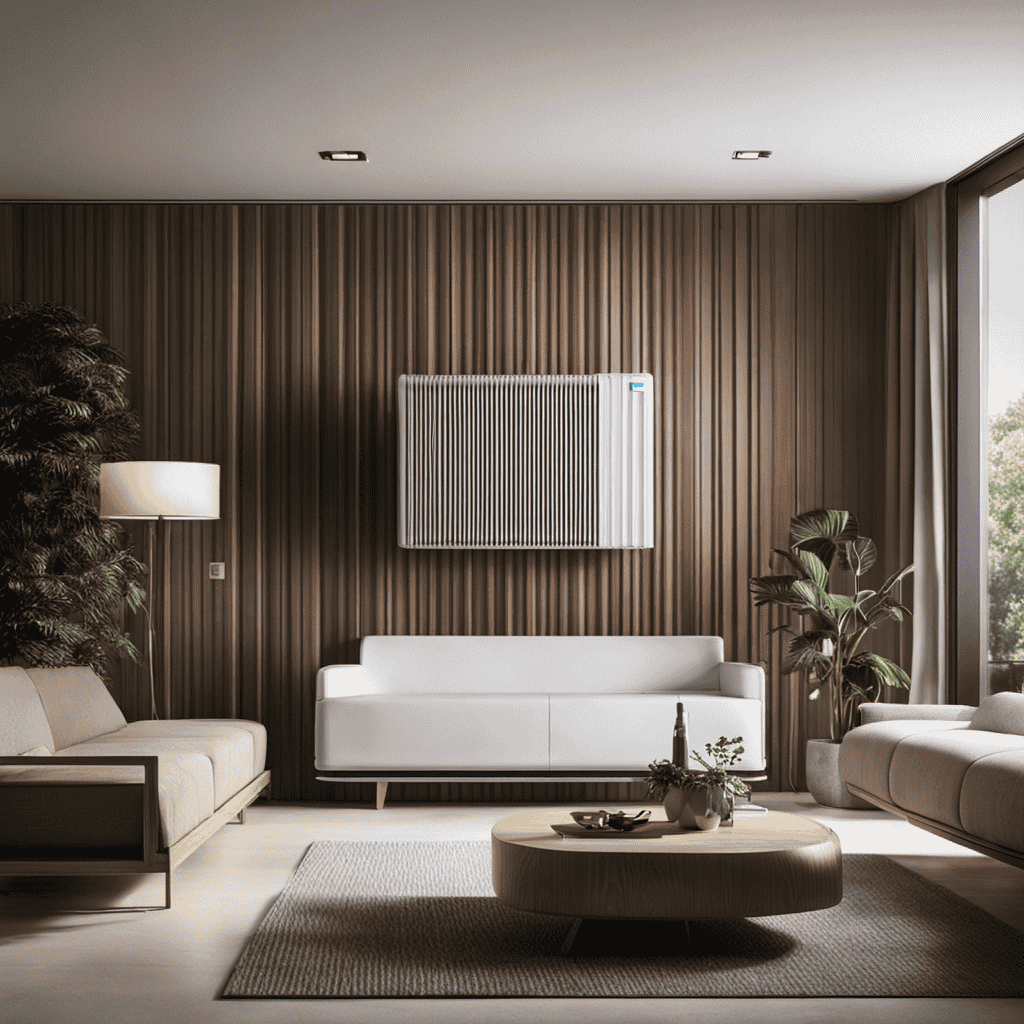As the owner of a Blueair air purifier, I understand the importance of regularly cleaning and maintaining it to ensure optimal performance.
In this article, I will guide you through the step-by-step process of cleaning your Blueair air purifier, ensuring that you maintain a healthy and clean environment in your home.
From understanding the importance of regular cleaning to establishing a long-term maintenance routine, I will provide you with detailed instructions on how to effectively clean your air purifier.
Let’s get started!
Key Takeaways
- Regular maintenance is crucial for efficient and effective Blueair air purifier operation.
- Use a soft, lint-free cloth and avoid abrasive cleaning agents when cleaning the air purifier.
- Regularly clean filters and follow recommended cleaning frequencies to ensure proper filtration and purification.
- Follow specific instructions for cleaning each component of the Blueair air purifier to maintain optimal air quality.
Understanding the Importance of Regular Cleaning
You should understand the importance of regularly cleaning your Blueair air purifier. Regular maintenance is crucial to keep your air purifier running efficiently and effectively.
Cleaning your air purifier on a consistent schedule ensures that it can properly filter and purify the air in your home. Neglecting regular cleaning can lead to a buildup of dust, dirt, and other particles, which can hinder the performance of your air purifier.
It is recommended to establish a cleaning schedule based on the manufacturer’s guidelines. This may involve cleaning the pre-filter, replacing the filters, and wiping down the exterior.
Gathering the Necessary Cleaning Supplies
When it comes to cleaning, having the right tools is essential for getting the job done effectively.
In this discussion, we will explore the essential cleaning tools that are necessary for a thorough cleaning routine.
Additionally, we will delve into the proper cleaning techniques that should be followed to ensure a clean and hygienic living space.
Essential Cleaning Tools
To clean your Blueair air purifier, gather the essential cleaning tools you’ll need. Here are the tools you’ll need for a thorough cleaning:
- Soft, lint-free cloth: This will help you wipe down the exterior and interior surfaces of the air purifier without scratching or damaging them.
- Vacuum cleaner with brush attachment: Use the brush attachment to gently remove dust and debris from the pre-filter and the main filter.
- Compressed air canister: This can be used to blow away dust and dirt from hard-to-reach areas, such as the fan blades and the sensor.
- Mild detergent or vinegar solution: Mix a small amount of mild detergent or vinegar with water to clean the plastic components of the air purifier.
Understanding proper techniques and choosing the right cleaning products is crucial to maintaining the performance and longevity of your Blueair air purifier. Follow these steps and your air purifier will be clean and ready to provide you with fresh, clean air once again.
Proper Cleaning Techniques
By using a soft, lint-free cloth, you’ll be able to wipe down both the exterior and interior surfaces of your air purifier without causing any damage. Regular maintenance is important for keeping your Blueair air purifier in optimal condition and ensuring it continues to effectively filter the air in your home. However, it’s essential to avoid common cleaning mistakes that can potentially harm your device. One common mistake is using abrasive or harsh cleaning agents, as they can scratch or damage the surface of your air purifier. Another mistake is neglecting to clean the filters regularly, which can lead to reduced efficiency and poor air quality. To emphasize the importance of regular maintenance, here is a table summarizing the key cleaning tasks and recommended frequency:
| Cleaning Task | Recommended Frequency |
|---|---|
| Wiping down surfaces | Weekly |
| Cleaning filters | Monthly |
| Vacuuming the vents | Quarterly |
Following these proper cleaning techniques will help ensure the longevity and effectiveness of your Blueair air purifier.
Powering Off and Unplugging the Air Purifier
You can easily power off and unplug the Blueair air purifier by pressing the power button and disconnecting the power cord. Understanding power usage and troubleshooting common issues are important for the proper functioning of your air purifier. Here are some key things to keep in mind:
- Check the power source: Ensure that the air purifier is connected to a properly functioning power outlet.
- Power button: Press the power button to turn off the purifier. This will stop the fan and other functions.
- Unplugging: After powering off, unplug the power cord from the outlet. This will ensure complete disconnection from the power source.
- Wait time: Allow a few minutes before plugging the air purifier back in, especially if you encountered any issues. This can help reset the system and resolve minor problems.
Removing the Outer Casing
When it comes to removing the outer casing of the air purifier, there are a few techniques that can be used.
It is important to have the right cleaning tools on hand, such as a screwdriver or pliers, to easily detach the casing.
Additionally, safety precautions should be taken during the disassembly process to prevent any accidents or damage to the air purifier.
Casing Removal Techniques
To remove the casing of your Blueair air purifier, start by unplugging the device and locating the release buttons. These buttons are usually located on the sides or back of the purifier. Once you have located them, press and hold them simultaneously.
As you do this, gently lift the casing upwards and away from the device. If you encounter any resistance, double-check that you have fully pressed the release buttons. If the casing still won’t budge, refer to the troubleshooting section of your user manual or contact Blueair customer support for assistance.
Now that you have successfully removed the casing, let’s move on to the next section: cleaning tools required.
Cleaning Tools Required
Now that we’ve covered the casing removal techniques, let’s discuss the tools you’ll need for cleaning.
When it comes to cleaning your Blueair air purifier, there are a few essential tools that will make the process much easier and more effective. First and foremost, you’ll need a vacuum cleaner with a brush attachment. This will help you remove any dust or debris from the filters and internal components.
Additionally, a soft microfiber cloth is great for wiping down the exterior of the purifier and removing any smudges or fingerprints. A small brush, like a toothbrush or paintbrush, can be used to clean hard-to-reach areas and crevices.
Finally, make sure to have a mild, non-abrasive cleaner or soap solution for deeper cleaning.
These tools, combined with proper cleaning techniques and regular maintenance, will ensure that your Blueair air purifier operates at its best.
Now, let’s move on to discussing the safety precautions during disassembly.
Safety Precautions During Disassembly
Before you begin taking apart the device, make sure to follow all necessary safety precautions. Disassembling an electronic device like the Blueair Air Purifier requires careful attention to ensure your safety and prevent any damage to the device. Here are some important precautions and safety measures to keep in mind:
- Always unplug the device before starting the disassembly process.
- Wear protective gloves to protect your hands from sharp edges or any potential harm.
- Work in a well-ventilated area to avoid inhaling any dust or particles.
- Keep all small parts and screws organized to prevent losing them during the disassembly.
By following these disassembling precautions and safety measures, you can ensure a safe and successful disassembly process.
Now that we have taken the necessary safety precautions, let’s move on to cleaning the pre-filter.
Cleaning the Pre-Filter
First, make sure you unplug the Blueair air purifier before beginning to clean the pre-filter. Cleaning the pre-filter is an essential part of maintaining the efficiency and longevity of your air purifier.
The pre-filter acts as the first line of defense, capturing larger particles such as dust, pet hair, and lint. Over time, these particles can accumulate and hinder the air purifier’s performance. Regular cleaning of the pre-filter ensures that it remains free from debris and allows for optimal airflow.
To clean the pre-filter, gently remove it from the air purifier and use a vacuum cleaner or a soft brush to remove the trapped particles. If the pre-filter is heavily soiled, it can also be rinsed under running water. Once cleaned, allow it to dry completely before reinserting it back into the air purifier.
Cleaning the Activated Carbon Filter
When it comes to maintaining carbon filters, there are a few key points to keep in mind.
First, proper maintenance is crucial to ensure the filters are working effectively. This includes regular cleaning techniques and tips, such as gently vacuuming or washing the filter with mild soap and water.
Lastly, it’s important to know the frequency of filter cleaning, as this will depend on factors such as the air quality in your area and the usage of the filter.
Proper Carbon Filter Maintenance
To properly maintain your Blueair air purifier’s carbon filter, you’ll need to regularly replace it according to the manufacturer’s instructions. Carbon filters play a crucial role in trapping odors, gases, and chemicals, ensuring clean and fresh air in your home.
Here are some important tips for carbon filter maintenance:
-
Check the manufacturer’s guidelines: Familiarize yourself with the recommended lifespan of the carbon filter and how often it should be replaced.
-
Monitor filter performance: Keep an eye on the air purifier’s indicator lights or monitor the air quality to determine when the carbon filter needs replacement.
-
Store spare filters properly: If you have extra carbon filters, store them in a cool, dry place away from direct sunlight to maintain their effectiveness.
-
Troubleshoot common issues: If you notice a decrease in air purifier performance, check for any clogs, damage, or signs of wear on the carbon filter.
Cleaning Techniques and Tips
Now that we’ve covered proper carbon filter maintenance, let’s move on to cleaning techniques and tips for your Blueair air purifier.
Cleaning your air purifier regularly ensures that it continues to function efficiently and effectively. To start, make sure you unplug the unit before cleaning.
For general cleaning, a soft, damp cloth can be used to wipe down the exterior surfaces of the air purifier. However, for a deeper clean, it’s recommended to use mild cleaning solutions specifically designed for electronics. These solutions help remove dirt, dust, and other particles that may have accumulated on the filters and inside the unit.
When cleaning the filters, refer to the manufacturer’s instructions for specific guidance on how to clean and maintain them properly.
Frequency of Filter Cleaning
Regularly maintaining and cleaning the filters of your Blueair air purifier ensures optimal performance and clean air for your home or office. Here are the reasons why regular maintenance is important and the benefits of clean filters:
-
Improved air quality: Clean filters trap and remove pollutants such as dust, pollen, pet dander, and smoke particles, ensuring cleaner and healthier air for you and your family.
-
Increased lifespan of the air purifier: Regular filter cleaning prevents clogs and reduces strain on the purifier’s motor, helping it last longer and operate more efficiently.
-
Energy efficiency: Clean filters allow the air purifier to work at its full capacity, saving energy and reducing electricity costs.
-
Reduced maintenance costs: By cleaning the filters regularly, you can prevent the need for costly repairs or replacements, saving you money in the long run.
Cleaning the HEPA Filter
Cleaning the HEPA filter is essential for maintaining optimal air quality in your Blueair air purifier. Understanding filter maintenance and following these tips can help prolong the life of your filter.
To clean the HEPA filter, start by turning off the purifier and unplugging it from the power source. Open the purifier and remove the filter. Gently vacuum the filter to remove any loose particles and dirt. If needed, you can also rinse the filter under running water. Allow the filter to dry completely before placing it back into the purifier.
It’s important to note that not all filters are washable, so always check the manufacturer’s instructions. Regularly cleaning the HEPA filter will ensure that your Blueair air purifier continues to provide clean and fresh air for years to come.
Cleaning the Ionizer Plates (If Applicable
If applicable, make sure to rinse the ionizer plates under running water before drying them completely. Cleaning the ionizer plates is an important part of maintaining your Blueair air purifier and ensuring its optimal performance. Here are some tips to help you clean the ionizer plates effectively:
- Disconnect the air purifier from the power source before cleaning to prevent any accidents.
- Gently remove the ionizer plates from the unit.
- Rinse the plates under running water to remove any dust or debris.
- Use a soft brush or cloth to clean any stubborn particles that may be stuck on the plates.
Cleaning the ionizer plates regularly will help to maintain the efficiency of your air purifier and ensure that it continues to provide you with clean and fresh air. If you encounter any issues during the cleaning process or notice that the cleaning indicator is not functioning properly, refer to the troubleshooting guide provided by Blueair or contact their customer support for assistance.
Cleaning the Fan Blades
To ensure optimal performance, regularly check and wipe down the fan blades to remove any dust or debris that may be affecting the airflow. Fan blade maintenance is crucial for prolonging the life of your fan and ensuring its efficiency. Dust and debris can accumulate on the blades over time, causing the airflow to be restricted and reducing the fan’s effectiveness. By cleaning the fan blades regularly, you can prevent this buildup and keep your fan running smoothly.
Here is a simple step-by-step guide on how to clean your fan blades:
| Steps | Materials Needed |
|---|---|
| Step 1 | Soft cloth |
| Step 2 | Mild detergent |
| Step 3 | Water |
| Step 4 | Screwdriver (if necessary) |
- Start by unplugging the fan and ensuring it is turned off.
- Use a soft cloth dampened with mild detergent and water to gently wipe down the fan blades, removing any dust or debris.
- If necessary, use a screwdriver to remove the fan blades for a more thorough cleaning.
- Once cleaned, dry the blades completely before reattaching them to the fan.
Cleaning the Air Quality Sensors (If Applicable
After cleaning the fan blades, it’s important to also take care of the air quality sensors in your Blueair air purifier. These sensors play a vital role in monitoring and maintaining the air quality in your home. If they become dirty or malfunction, it can affect the overall performance of the purifier.
Here are some steps to clean the sensor components and troubleshoot any issues:
- Disconnect the air purifier from the power source and remove the front panel.
- Locate the air quality sensors, usually found near the intake vents.
- Gently wipe the sensors with a soft, dry cloth to remove any dust or debris.
- If the sensors are still not functioning properly, refer to the user manual for further troubleshooting steps or contact Blueair customer support for assistance.
Regularly cleaning and maintaining the sensor components will ensure that your Blueair air purifier continues to provide optimal air quality in your home.
Cleaning the Control Panel and Buttons
When cleaning the control panel and buttons, be sure to use a gentle, non-abrasive cleaner. This is important to avoid damaging the sensitive components and to ensure the longevity of your Blueair air purifier.
To start, turn off and unplug the purifier. Dampen a soft cloth with the cleaner and gently wipe the control panel and buttons. Avoid spraying the cleaner directly onto the surface to prevent any liquid from seeping into the electronic parts.
Pay attention to any stubborn stains or dirt buildup and gently scrub them away. Once you have cleaned the control panel and buttons, make sure to dry them thoroughly before plugging in and turning on the air purifier.
Cleaning the Air Intake and Outlet Vents
To ensure proper functioning of your device, regularly wipe down the air intake and outlet vents with a soft cloth and gentle cleaner. Cleaning the air intake and outlet vents is essential to maintain the efficiency of your Blueair air purifier. Here are some important steps to follow:
- Turn off and unplug the air purifier before cleaning.
- Gently remove the front grille to access the filter components.
- Use a soft cloth or brush to remove any visible dust and debris from the vents.
- If there are stubborn stains or dirt, you can use a mild cleaner or soapy water to gently clean the vents.
Reassembling the Air Purifier
To reassemble your device, simply follow these steps to ensure all components are properly aligned and secured.
First, take the casing and position it correctly over the internal components. Make sure that all the tabs and grooves line up perfectly to ensure a snug fit. Gently press the casing down until you hear a click, indicating that it is securely in place.
Next, check the air intake and outlet vents to ensure they are clear of any debris or obstructions. Proper airflow is crucial for the optimal performance of your air purifier.
Once you have confirmed that everything is aligned and the vents are clear, you can proceed to the next step: testing the air purifier after cleaning.
Testing the Air Purifier After Cleaning
After reassembling your device, you can now check if it is working properly by performing a simple test. Here’s how you can ensure the testing accuracy and measure the performance of your Blueair air purifier:
- Power on the air purifier and set it to the highest fan speed.
- Place a piece of tissue paper or a smoke test near the air intake of the purifier.
- Observe how quickly the purifier captures the smoke or causes the tissue to move.
- Use an air quality monitor to measure the improvement in air quality before and after running the purifier.
By following these steps, you can determine if your air purifier is functioning effectively and efficiently. It’s important to regularly test your purifier to ensure it is providing clean and healthy air in your space.
Now let’s move on to establishing a cleaning routine for long-term maintenance.
Establishing a Cleaning Routine for Long-Term Maintenance
Establishing a regular cleaning schedule is crucial for maintaining the long-term performance and efficiency of your air purifier. By following a cleaning routine, you can ensure that your Blueair air purifier continues to effectively remove pollutants from the air, providing you with clean and healthy indoor air. Regular maintenance also helps prolong the lifespan of your air purifier and prevents any potential issues or malfunctions.
One of the benefits of establishing a cleaning schedule is that it helps keep your air purifier running at optimal performance. Over time, dust, pet dander, and other particles can accumulate on the filters, reducing their effectiveness. By regularly cleaning or replacing the filters, you can ensure that your air purifier continues to capture airborne contaminants efficiently.
Here is a simple table that outlines a recommended cleaning schedule for your Blueair air purifier:
| Cleaning Task | Frequency |
|---|---|
| Filter Replacement | Every 6-12 months |
| Pre-filter Cleaning | Every 2-4 weeks |
| Unit Cleaning | Every 3-6 months |
Following this cleaning schedule will help you maintain the performance and longevity of your Blueair air purifier. Remember, regular maintenance is key to enjoying the full benefits of your air purifier and breathing cleaner air in your home.
Frequently Asked Questions
How Often Should I Clean My Blueair Air Purifier?
I clean my Blueair air purifier every 3-6 months to keep it running efficiently. To clean it, I follow the manufacturer’s instructions, which usually involve wiping the exterior and replacing the filters.
Can I Use Any Cleaning Supplies or Are There Specific Ones Recommended for Cleaning the Air Purifier?
I can use any cleaning supplies to clean my air purifier, but it’s recommended to use specific ones for better results. There are alternative cleaning methods available as well, which can be explored for maintenance.
Is It Safe to Clean the Air Quality Sensors Myself?
Yes, it is safe to clean the air quality sensors yourself. However, it is important to follow the cleaning tips and maintenance guidelines provided by Blueair to ensure proper care and functionality of the sensors.
Should I Clean the Control Panel and Buttons With Water or a Cleaning Solution?
I usually clean the control panel and buttons of my air purifier with a damp cloth and mild cleaning solution. It’s important to avoid using excessive water to prevent damage to the electronic components. Regular cleaning helps maintain the overall cleanliness of the air purifier.
How Do I Establish a Cleaning Routine for Long-Term Maintenance of My Blueair Air Purifier?
To establish a cleaning routine for long-term maintenance of my Blueair air purifier, I follow these steps: remove and wash the filters, wipe down the exterior with a damp cloth, and clean the control panel with a mild solution.
Is It Important to Clean the Air Purifier Itself, or Just the Filter?
When it comes to cleaning blue air purifier filters, it’s important to remember that the actual purifier unit also needs to be maintained. While regularly cleaning or replacing the filter is crucial for optimal performance, the purifier itself can accumulate dust and bacteria if not cleaned regularly.
Conclusion
In conclusion, keeping your Blueair air purifier clean is essential for maintaining its performance and prolonging its lifespan. By following the steps outlined in this article, you can ensure that your air purifier is effectively removing pollutants from your indoor air.
Remember the old saying, ‘A clean air purifier is a happy air purifier.’ So, make it a habit to regularly clean and maintain your Blueair air purifier to enjoy clean and fresh air in your home for years to come.










